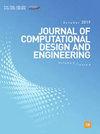A study on UCV path planning for collision avoidance with enemy forces in dynamic situations
IF 6.1
2区 工程技术
Q1 COMPUTER SCIENCE, INTERDISCIPLINARY APPLICATIONS
引用次数: 0
Abstract
Abstract This study focuses on the path planning problem for Unmanned Combat Vehicles (UCVs), where the goal is to find a viable path from the starting point to the destination while avoiding collisions with moving obstacles, such as enemy forces. The objective is to minimize the overall cost, which encompasses factors like travel distance, geographical difficulty, and the risk posed by enemy forces. To address this challenge, we have proposed a heuristic algorithm based on D* lite. This modified algorithm considers not only travel distance but also other military-relevant costs, such as travel difficulty and risk. It generates a path that navigates around both fixed unknown obstacles and dynamically moving obstacles (enemy forces) that change positions over time. To assess the effectiveness of our proposed algorithm, we conducted comprehensive experiments, comparing and analyzing its performance in terms of average pathfinding success rate, average number of turns, and average execution time. Notably, we examined how the algorithm performs under two UCV path search strategies and two obstacle movement strategies. Our findings shed light on the potential of our approach in real-world UCV path planning scenarios.动态情况下无人潜航器避碰路径规划研究
摘要研究了无人作战车辆(ucv)的路径规划问题,其目标是在避免与移动障碍物(如敌军)碰撞的情况下,找到一条从起点到目的地的可行路径。目标是尽量减少总成本,其中包括旅行距离、地理困难和敌军构成的风险等因素。为了解决这一挑战,我们提出了一种基于D* lite的启发式算法。改进后的算法不仅考虑了飞行距离,还考虑了其他军事相关成本,如飞行难度和风险。它生成的路径既可以绕过固定的未知障碍,也可以绕过随时间改变位置的动态移动障碍(敌军)。为了评估我们提出的算法的有效性,我们进行了全面的实验,从平均寻径成功率、平均回合数和平均执行时间三个方面对其性能进行了比较和分析。值得注意的是,我们研究了该算法在两种UCV路径搜索策略和两种障碍物移动策略下的表现。我们的研究结果揭示了我们的方法在现实世界UCV路径规划场景中的潜力。
本文章由计算机程序翻译,如有差异,请以英文原文为准。
求助全文
约1分钟内获得全文
求助全文
来源期刊

Journal of Computational Design and Engineering
Computer Science-Human-Computer Interaction
CiteScore
7.70
自引率
20.40%
发文量
125
期刊介绍:
Journal of Computational Design and Engineering is an international journal that aims to provide academia and industry with a venue for rapid publication of research papers reporting innovative computational methods and applications to achieve a major breakthrough, practical improvements, and bold new research directions within a wide range of design and engineering:
• Theory and its progress in computational advancement for design and engineering
• Development of computational framework to support large scale design and engineering
• Interaction issues among human, designed artifacts, and systems
• Knowledge-intensive technologies for intelligent and sustainable systems
• Emerging technology and convergence of technology fields presented with convincing design examples
• Educational issues for academia, practitioners, and future generation
• Proposal on new research directions as well as survey and retrospectives on mature field.
 求助内容:
求助内容: 应助结果提醒方式:
应助结果提醒方式:


